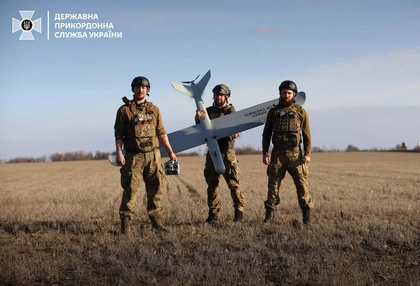Slightly after dusk on Sep. 22, Ukrainian air defense operators near Mykolaiv in southern Ukraine detected a swarm of Russian drones volleying over the front lines. Coming at them were some of Moscow’s newest weapons – Iranian–made Shaheed-136s.
Russian President Vladimir Putin had trumpeted the purchase of these “suicide drones” after his July visit to Iran, placing great stock in both their precision strike capabilities and reputed stealth. But Moscow and Tehran were both in for a shock.
JOIN US ON TELEGRAM
Follow our coverage of the war on the @Kyivpost_official.
Within minutes, all attacking drones were brought down. The destruction of four Shaheed–136s in a single engagement wasa feat never before achieved by Ukraine, nor any other military power. But the shootdown was just the latest victory in an amazing comeback story.
From near defeat to air dominance
In the opening days of Russia’s full-scale invasion, Ukraine’s air defense network was quickly overwhelmed. Stripped of their protection, Ukrainian cities were hammered by sores of Russian cruise missiles. Across the country, Russian aircraft were able to carry out deep strikes on airfields, wiping out many Ukrainian aircraft in their hangars. For a time, Russian fighters prowled at will, shooting down the few planes that Ukraine got airborne.

Wazzup With Witkoff?, War Crimes and Children, Buzzing Around Belgorod
After Russia’s onslaught, Ukraine worked to re-establish an integrated air defense network. This included the careful repositioning of surface-to–air missiles to protect cities and critical infrastructure. Perhaps most importantly, air defense systems were deployed to remote air strips to defend Ukraine’s few remaining combat aircraft. By these means, Ukraine was gradually able to take back portions of its skies.
Russia’s use of frontal aviation was blunted by the distribution of man portable anti-aircraft missiles, including U.S. made Stingers and Ukraine’s own Igla MANPADS. With Russia’s air superiority fighters kept at bay, Ukraine was gradually able to increase the number of its own close air support missions.
By early spring, fearing Ukraine’s re-established long-range air defense, Russian strategic bombers no longer dared to venture over Ukraine. Moscow had to content itself with firing cruise missiles from Belarusian airspace, or even as far away as the Caspian Sea.
Ukraine, given more time to react, was able to shoot down many of these incoming missiles, saving hundreds of lives. Russia’s air superiority was whittled away, and Moscow’s problems were about to get worse.
Game changer
In mid-summer, NATO delivered a weapon to Ukraine that changed the air war: the HARM anti-radiation missile.Designed to target Russian air defense complexes, the HARM was highly capable albeit originally designed for western aircraft. Thanks to some sterling ingenuity, the Ukrainian Armed Forces (UAF) made this NATO-standard missile work with their own MiG and Sukhoi fighters.
Technical problems were soon overcome, and systems checks quickly conducted. All that remained to be tested was the audacity of Ukrainian pilots. They would not disappoint.
The operation was titled Suppression of Enemy Air Defense (SEAD). It requires pilots to deliberately fly close to enemy surface-to-air missile batteries, literally daring them to fire. In late July, Ukraine launched its first SEAD missions. Flying carefully chosen routes, and using terrain to mask their approaches, Ukrainian pilots caught the Russians napping.
By the time the Russian air defense attempted to lock on to the attacking fighters, the HARMs were in the air and on the way. Now, it was the missiles’ turn to deliver an unpleasant surprise. The HARM on-board computers are not only able to track and hit mobile air defense systems but locate surface to air batteries that have switched off their radars. The HARMs closed on their targets at more than three times the speed of sound, varying their approaches as they came. The Russians had little time to react.
On July 26 and 27, two of Russia’s most capable S-300 air defense complexes were reported destroyed. One after another, Russian air defense sites were neutralized, and mobile Buk–M and Pantsir systems, some of them hidden in barns and outbuildings, fared no better. First by ones and twos, and then by fives and tens, Russian missile sites began to burn.
On Sep. 22, the Ukrainian General Staff announced that 15 Russian air defense complexes had been destroyed.
Turning of the tide
Suppression of the Russian air defense has had several important second order effects. The destruction of air surveillance radars has prevented Russia from vectoring its own air–superiority fighters against Ukrainian close air support missions.
By maneuvering its own mobile air defense units, the UAF has been able to establish localized air dominance –increasing close air support missions to support offensive ground force operations. The successes of the Kharkiv and Kherson offensives have been helped immeasurably by Ukraine’s ability to concentrate air power along the front lines.With Ukraine’s air force now resurgent, a state of “air parity”may now be said to exist over Ukraine.
The campaign against air defenses also prevents Russianforces from detecting the launch of precision strike munitions. On Sep. 22, a train load of Russian tanks and infantry fighting vehicles was struck by HIMARS missiles just as it pulled into the rail station in the city of Donetsk.
The next day, the commander of the Russian 144th Motorized Rifle Division, Major General Oleg Tsokov, was seriously wounded when a long–range strike munition slammed into his headquarters near Svatove. Several senior members of his staff were killed. There was no warning, and nothing Russia could do to intercept the strike.
All of this has been made possible by the selective targeting of Russian air defenses. In the skies above Ukraine, the tide has been turning – and now the Russians know it.
Charles ‘Chuck’ Pfarrer is an American writer, film producer and former U.S. Navy SEAL.
The views expressed in this article are those of the author and not necessarily of Kyiv Post.
You can also highlight the text and press Ctrl + Enter











